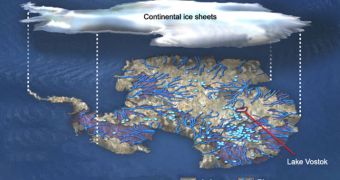After more than 20 years of drilling in the Antarctic ice sheet, Russian explorers are getting ready to penetrate the surface of Lake Vostok, and underground body of water that has been covered by ice millions of years ago. Their drill bit is a short distance away from its target.
According to estimates, it's been more than 14 million years since the surface of the lake has had any sort of contact with the outside world. Undoubtedly, every single organism that was present in the lake at the time it was sealed can still be found there.
There is currently no doubt in scientists' minds that bacteria and microbes in the lake are still pretty much alive, despite the harsh conditions they live in. Recently, an investigator found 34,000-year-old bacteria living in suspended animation in salt crystals, so anything is possible.
In fact, this is what the Russian experts are expecting to achieve – the discovery of new bacteria or microbe species, that lived and evolved in isolation from the rest of the world for a long time.
One of the things that researchers find most interesting about this particular Antarctic feature is that it remained separate from the 150+ other subglacial lakes on the Southern Continent. Additionally, it contains levels of oxygen that are up to 50 times higher than in any other similar lake.
There are however many dangers associated with breaching the frozen surface of the lake, not the least of which is contamination by “modern” organisms. In all respects, the even needs to take place in a sterile environment, similar to that of an operations room.
This is made hard by the fact that Lake Vostok is located some 2.5 miles below the Antarctic ice sheet. Experts with the Arctic and Antarctic Research Institute, in St. Petersburg, have been working on reaching it since 1990, showing a lot of patience as they did so.
Now, the team can finally complete the work because it was able to set up a mechanism that would prevent cross-contamination. Expert Valery Lukin told New Scientist about the system, Wired reports.
“Once the lake is reached, the water pressure will push the working body and the drilling fluid upwards in the borehole, and then freeze again,” he explained, saying that the first effort to penetrate the lake will most likely take place the next season.
He added that the drill bit used to reach the underground lake is now located some 328 feet above its surface. The critical threshold is 65 to 98 feet. Once this level is reached, the team will replace the drill with a thermally-operated lance.
After the first samples are collected, experts will analyze them thoroughly. They hope to obtain new data about how Earth looked like some 14 million years ago.
The group also hopes to determine how evolution operates in secluded environments, where outside influences are minimal.

 14 DAY TRIAL //
14 DAY TRIAL //